Abstract
Background:
Osteoarthritis is a chronic musculoskeletal condition that frequently affects the hip and knee joints. Given the burden associated with surgical intervention for hip and knee osteoarthritis, patients continue to search for potential non-operative treatments. One biologic therapy with mixed clinical and basic science evidence for treating osteoarthritis is platelet-rich plasma injections into the affected joint. We used the Google Trends tool to provide a quantitative analysis of national interest in platelet-rich plasma injections for hip and knee osteoarthritis.
Methods:
Google Trends parameters were selected to obtain search data from January 2009 to December 2019. Various combinations of ‘arthritis’, ‘osteoarthritis’, ‘PRP’, ‘platelet-rich plasma’, ‘knee’, and ‘hip’ were entered into the Google Trends tool and trend analyses were performed.
Results:
Three linear models were generated to display search volume trends in the United States for platelet-rich plasma and osteoarthritis, hip osteoarthritis, and knee osteoarthritis, respectively. All models showed increased Google queries as time progressed (p < 0.001), with R2 ranging from 0.837 to 0.940. Seasonal, income-related, and geographic variations in public interest in platelet-rich plasma for osteoarthritis were noted.
Conclusion:
Our results demonstrate a significant rise in Google queries related to platelet-rich plasma injections for osteoarthritis of the hip and knee since 2009. Surgeons treating hip and knee osteoarthritis patients can expect continued interest in platelet-rich plasma, despite inconclusive clinical and basic science data. Trends in public interest may inform patient counseling, shared decision-making, and directions for future clinical research.
Keywords: Google trends, hip, knee, osteoarthritis, platelet-rich plasma, PRP
Introduction
To date, there is no cure for osteoarthritis, with most treatments focused on reducing pain and improving quality of life for osteoarthritis patients. As such, establishing safe, effective treatments for hip and knee osteoarthritis is an area of active research with the potential for immense physical and economic impact. Platelet-rich plasma (PRP) joint injections are one biologic therapy that has received increased attention for treatment of hip and knee osteoarthritis [1]. PRP has been explored as a potential biologic treatment for various musculoskeletal injuries and conditions including anterior cruciate ligament reconstruction, degenerative spine disease, and rotator cuff repair [2–4]. Despite its increased utilization, evidence regarding the efficacy of PRP for osteoarthritis is mixed, with a recent article that examined 18 randomized controlled trials regarding the use of PRP for hip and knee osteoarthritis concluding that the effects of PRP on osteoarthritis disease progression are unclear [5].
One potential mechanism for increased PRP usage for hip and knee osteoarthritis despite a lack of proven safety and efficacy may be public requests for PRP therapy. Reports on elite athletes and celebrities experiencing beneficial effects after PRP treatment have increased public awareness regarding PRP therapy over the past several years, despite the fact that media portrayals of PRP are often misleading and rarely discuss the limitations or efficacy of the therapy [6]. The substantial revenue generated from PRP injection for osteoarthritis when compared with Medicare reimbursement for other treatments such as steroid injection may also be contributing to rising PRP usage [7]. The lucrative, expanding market for PRP therapy to treat hip and knee osteoarthritis suggests increasing popularity [8,9]. However, public interest in PRP therapy for hip and knee osteoarthritis remains unquantified. One method to quantify public interest in a novel treatment such as PRP therapy for hip and knee osteoarthritis is through internet search traffic data. Google Trends is a free, open-source tool that can be used to track public interest in search terms that are entered into the Google search engine. Previously, Google Trends data has been associated with actual healthcare utilization for a variety of both surgical and non-surgical procedures [10–12]. In addition, the Google Trends tool was recently used to track public interest in stem cell injections, another novel and increasingly popular therapy for hip and knee osteoarthritis [13].
The purpose of this study is to explore the utility of the Google Trends tool to track trends in public interest in information regarding PRP therapy for hip and knee osteoarthritis. We asked whether temporal, seasonal, income-related, or geographic trends in public interest in PRP therapy existed to influence the public’s interest in PRP therapy for hip and knee osteoarthritis; trends in public interest may contain implications for patient counseling, shared decision-making, and future clinical research.
Materials and Methods
Google Trends
Google Trends analyses can be customized by search term, time period, and geographic location. After a search term is entered into Google Trends and the appropriate temporal and geographic constraints specified, Google Trends generates visuals and outputs that reflect the volume of a given search term relative to peak popularity within the defined time period, which is assigned a value of 100. The data are presented as relative search volume (RSV), which is computed as the percentage of searches of a term in a location during a specific period of time. An RSV value of 100 indicates the largest ratio between searches for a specific topic and the total amount of Google queries. A value of 0 indicates that at the specified time point, the proportion of queries for the search term was less than 1% of its peak RSV [14].
Search Terms
We identified potential search terms after a thorough literature review of previous Google Trends studies focused on hip and knee osteoarthritis [13,15]. We also discussed potential search engine inputs related to PRP injections for hip and knee osteoarthritis. Combinations and permutations of ‘arthritis,’ ‘osteoarthritis,’ ‘platelet-rich plasma,’ ‘PRP,’ ‘injection,’ ‘knee,’ ‘hip,’ ‘knee osteoarthritis,’ and ‘hip osteoarthritis’ were discussed. Ultimately, three different combinations of search terms were selected to be incorporated into linear, quadratic, and exponential models describing public interest in PRP for 1) osteoarthritis, 2) hip osteoarthritis, and 3) knee osteoarthritis. The first set of models examining public interest in PRP for osteoarthritis utilized the keywords ‘arthritis,’ ‘osteoarthritis,’ ‘PRP,’ and ‘platelet-rich plasma’. The second set of models examining public interest in PRP for hip osteoarthritis utilized the keywords ‘hip arthritis,’ ‘hip osteoarthritis,’ ‘PRP,’ and ‘platelet-rich plasma’. The third set of models examining public interest in PRP for knee osteoarthritis utilized the keywords ‘knee arthritis,’ ‘knee osteoarthritis,’ ‘PRP,’ and ‘platelet-rich plasma’.
Temporal Trends
In order to study temporal trends in public interest in PRP for osteoarthritis, hip osteoarthritis, and knee osteoarthritis, combinations and permutations of the search terms relevant to each of the three models were entered into the Google Trends tool to create a database for the interest volume per term from January 2009 to December 2019 within the United States. SPSS Statistics version 26.0.0.1 was used to generate linear, quadratic, and exponential growth models describing changing public interest over time for the set of search terms related to PRP and osteoarthritis, PRP and hip osteoarthritis, and PRP and knee osteoarthritis. Model strength was determined using standard measures of accuracy (mean absolute percentage error, mean absolute deviation, and mean squared deviation). Regression analysis was used to evaluate whether or not public interest significantly increased as time progressed.
Seasonal Trends
In order to describe seasonal variations in public interest in PRP treatment for osteoarthritis of the hip and knee, monthly Google Trends values from January 2009 to December 2019 for the combinations of search terms used to inform the hip and knee osteoarthritis growth models (‘PRP’, ‘platelet-rich plasma’, ‘knee arthritis’, ‘knee osteoarthritis’, ‘hip arthritis’, ‘hip osteoarthritis’) were grouped by month and season (Winter: December–February, Spring: March–May, Summer: June–August, Fall: September–November). Seasonal trends in public interest in PRP for hip and knee osteoarthritis were noted.
Income-Related Trends
In order to describe potential income-related differences in public interest in PRP for hip and knee osteoarthritis within the United States, public interest in PRP for hip and knee osteoarthritis was recorded in the 5 states with the highest median income in the United States (Maryland, New Jersey, Hawaii, Massachusetts, and Connecticut) and the 5 states with the lowest median income in the United States (Mississippi, West Virginia, Arkansas, New Mexico, and Louisiana), respectively [16]. Google Trends data was averaged across the 5 highest income states and 5 lowest income states and a “High Income Growth Model” and “Low Income Growth Model” for public interest in PRP for hip and knee osteoarthritis were generated. Trends in growth in public interest in PRP for hip and knee osteoarthritis in both the high income states and the low income states were noted.
Geographic Trends
In order to describe potential geographic differences in public interest in PRP for hip and knee osteoarthritis, public interest in PRP for hip and knee osteoarthritis was recorded in the 5 largest cities in the United States, each of which is located in a different region of the country: New York, NY; Los Angeles, CA; Chicago, IL; Houston, TX; and Phoenix, AZ. Slopes of trend lines were compared to describe where public interest in PRP for hip and knee osteoarthritis changed the most rapidly.
Results
Temporal Trends
Search volume consistently increased throughout the study period from January 2009 to December 2019 for all three linear models generated. When comparing the 3 sets of models, search volume related to knee osteoarthritis (Figure 1C) increased more rapidly than search volume associated with hip osteoarthritis (Figure 1B) or osteoarthritis alone (Figure 1A). The linear model was determined to have the strongest measures of accuracy for all trends analyzed, with mean absolute percentage errors ranging from 5.14% to 6.34 %. Public interest in PRP for osteoarthritis, hip osteoarthritis, and knee osteoarthritis increased significantly over time (all models p < 0.001). R-squared values ranged from 0.837 to 0.940.
Figure 1C: Linear trend model for PRP and Knee Arthritis.
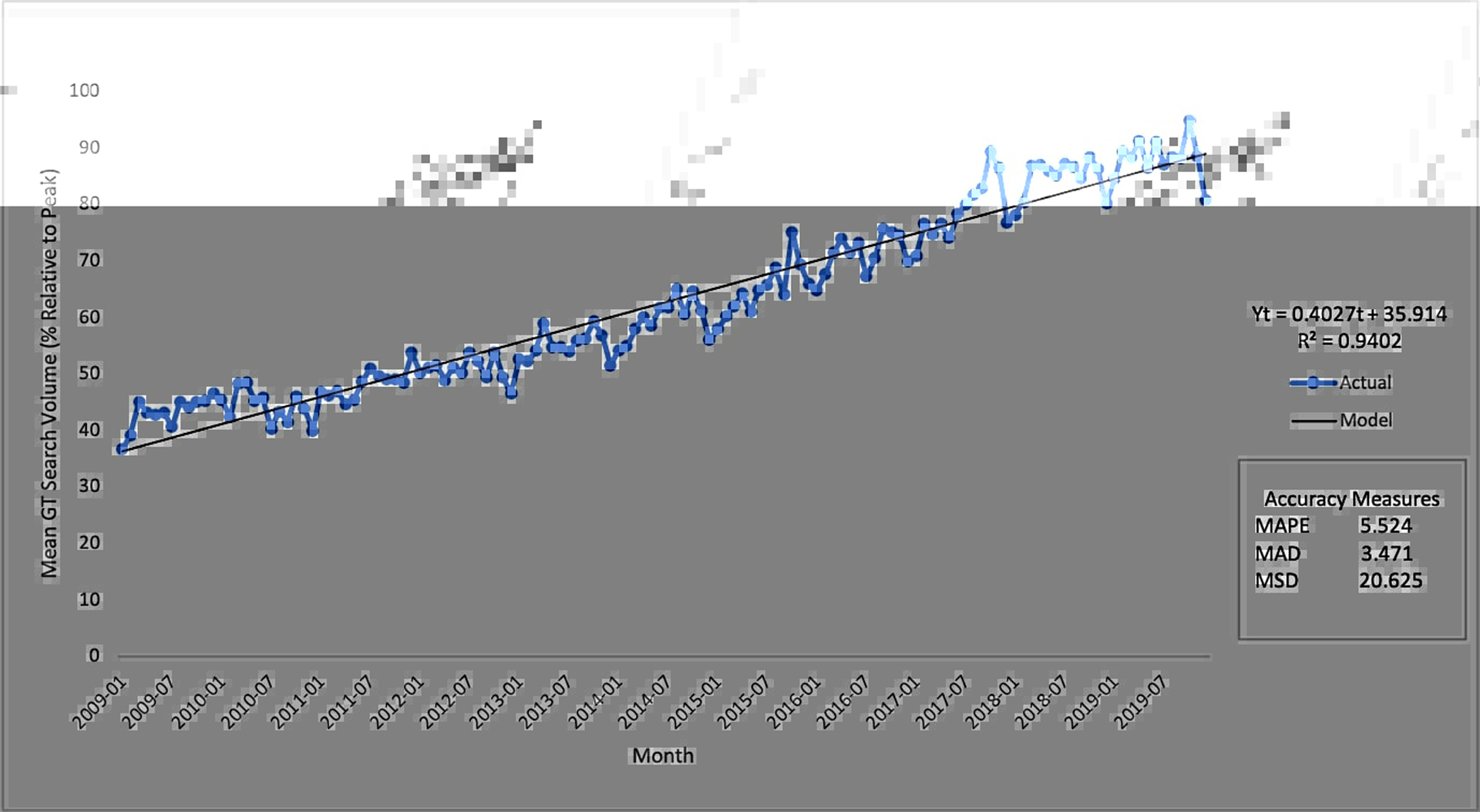
Linear trend model for platelet-rich plasma and knee osteoarthritis, 2009–2019. MAPE, mean absolute percentage error; MAD, mean absolute deviation; MSD, mean squared deviation; GT, Google Trends.
Figure 1B: Linear trend model for PRP and Hip Arthritis.
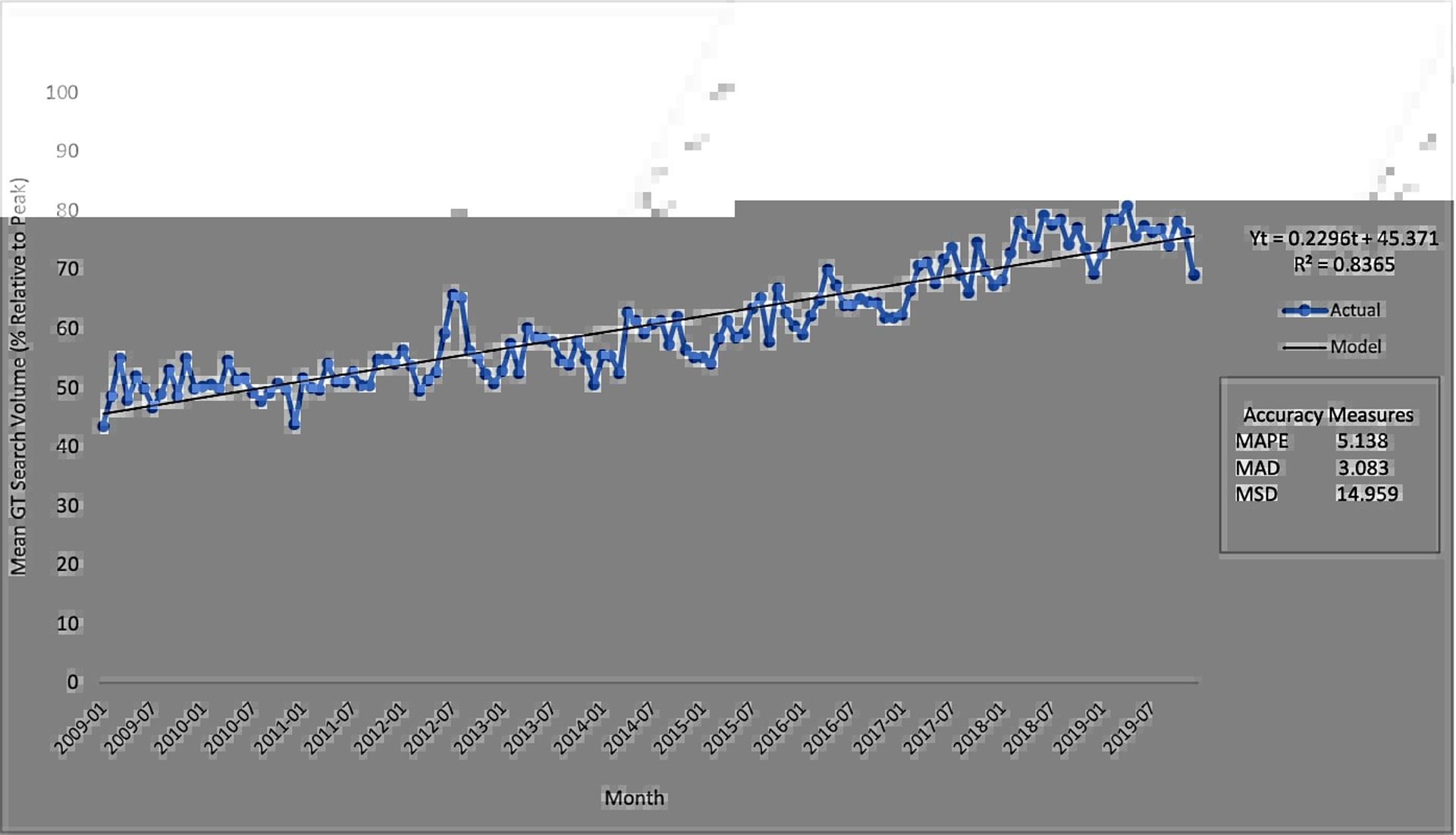
Linear trend model for platelet-rich plasma and hip osteoarthritis, 2009–2019. MAPE, mean absolute percentage error; MAD, mean absolute deviation; MSD, mean squared deviation; GT, Google Trends.
Figure 1A: Linear trend model for PRP and Osteoarthritis.
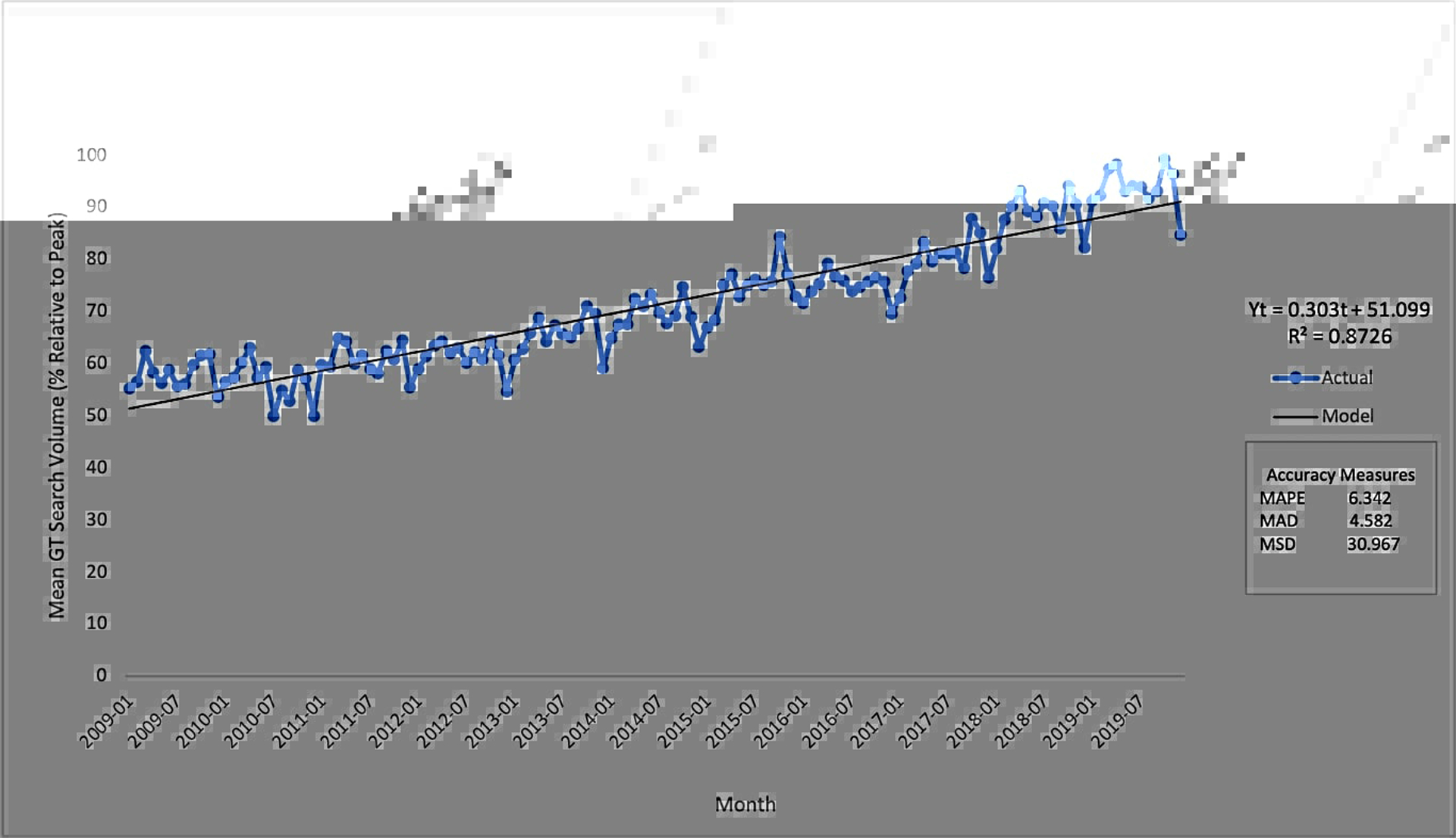
Linear trend model for platelet-rich plasma and osteoarthritis, 2009–2019. MAPE, mean absolute percentage error; MAD, mean absolute deviation; MSD, mean squared deviation; GT, Google Trends.
Seasonal Trends
Greatest public interest in PRP for hip and knee osteoarthritis was observed in the month of October while least public interest was observed in the month of January (Table 1). Seasonal Google Trends values show similar public interest in PRP for hip and knee osteoarthritis in the spring, summer, and fall season but decreased public interest in the winter season (Table 2).
Table 1:
Monthly Google Trends Search Volumes for PRP and Hip/Knee Arthritis, 2009–2019
| Month | Mean Google Trends Search Volumes (% Relative to Peak) |
|---|---|
| January | 57.8 |
| February | 59.6 |
| March | 61.3 |
| April | 63.1 |
| May | 61.2 |
| June | 62.7 |
| July | 62.6 |
| August | 63.3 |
| September | 61.5 |
| October | 65.1 |
| November | 62.7 |
| December | 59.1 |
Table 2:
Seasonal Google Trends Search Volumes for PRP and Hip/Knee Arthritis, 2009–2019
| Season | Mean Google Trends Search Volumes (% Relative to Peak) |
|---|---|
| Winter | 58.9 |
| Spring | 61.9 |
| Summer | 62.8 |
| Fall | 63.1 |
Income-Related Trends
Search volume trends in the five highest income states showed more rapid growth in interest in PRP for hip and knee osteoarthritis than in the five lowest income states (Figure 2).
Figure 2: Linear trend model for PRP and Hip/Knee Arthritis in Highest/Lowest Income States.
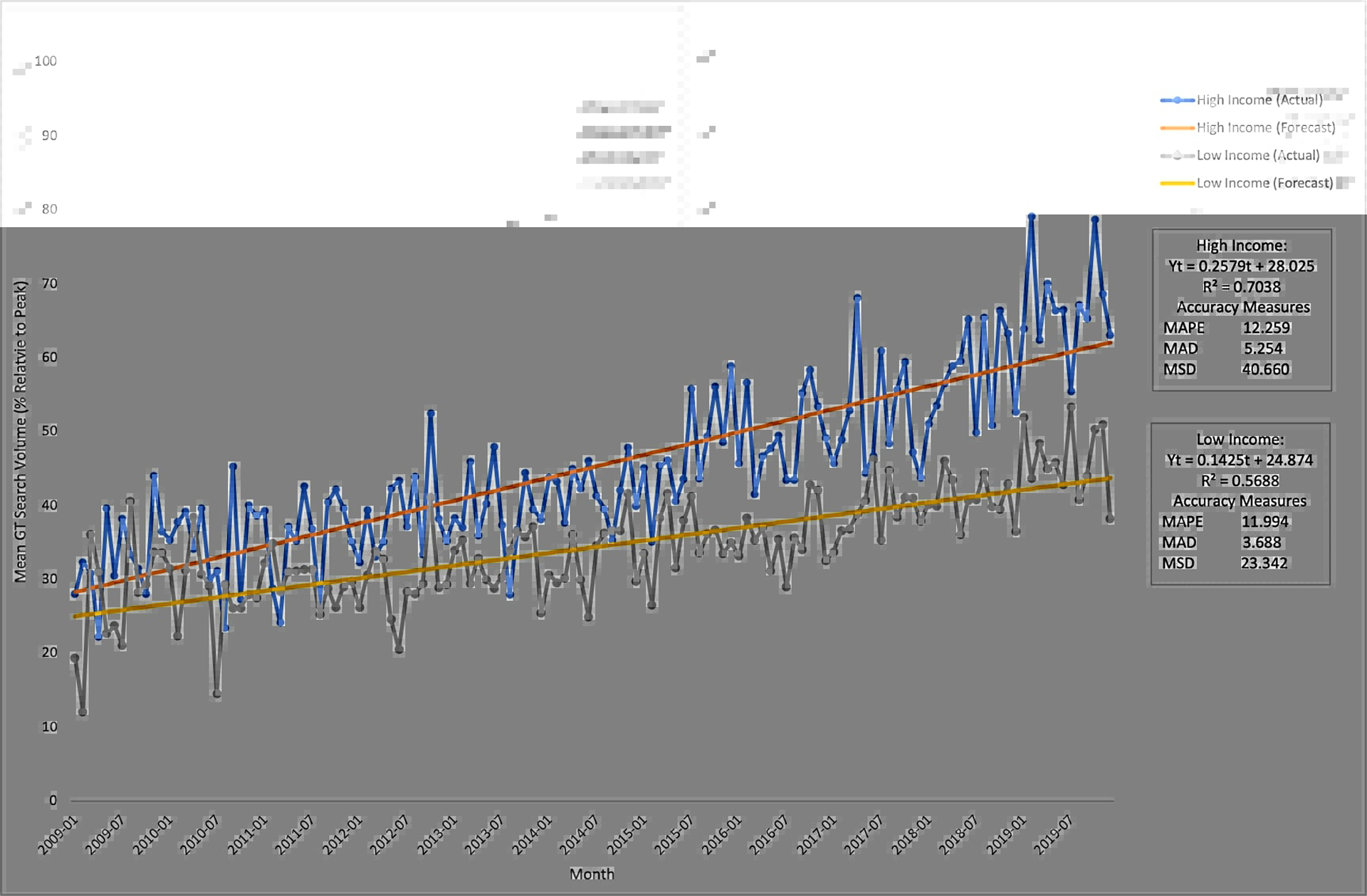
Linear trend model for platelet-rich plasma and hip/knee osteoarthritis in the five highest income and five lowest income states, 2009–2019. MAPE, mean absolute percentage error; MAD, mean absolute deviation; MSD, mean squared deviation; GT, Google Trends.
Geographic Trends
Search volume trends showed fastest growth in interest in PRP for hip and knee osteoarthritis in New York City and Los Angeles followed by Phoenix, Chicago, and Houston (Figure 3).
Figure 3: Linear trend model for PRP and Hip/Knee Arthritis in the 5 Largest Cities in the United States.
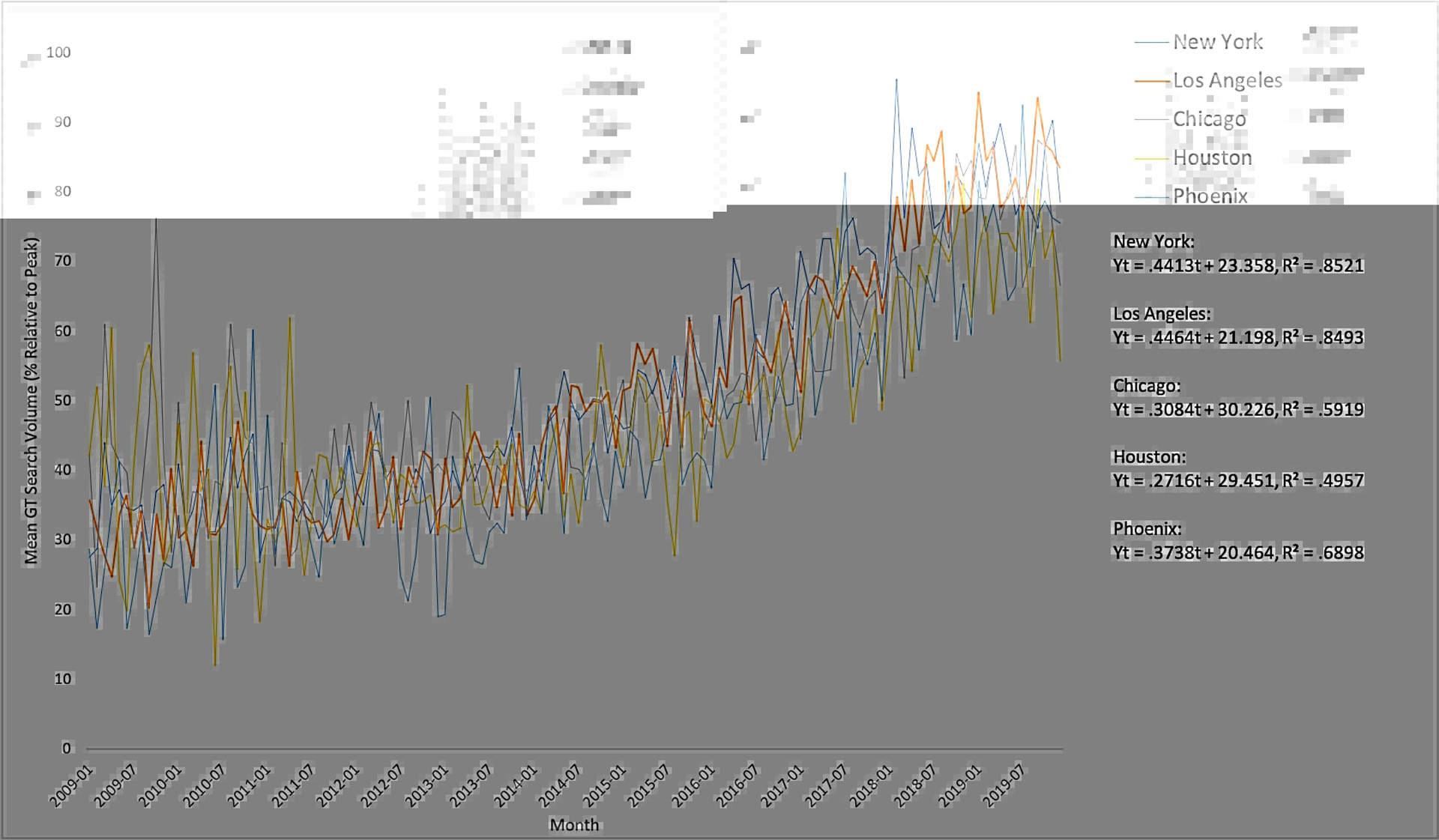
Linear trend model for platelet-rich plasma and hip/knee osteoarthritis in the five largest cities in the United States, 2009–2019. GT, Google Trends.
Discussion
In this study, we applied the Google Trends tool to track public interest in PRP therapy for hip and knee osteoarthritis. Our results show an increase in the number of searches related to PRP for hip and knee osteoarthritis from 2009 to 2019, with a greater increase in public interest related to PRP for knee compared to hip osteoarthritis. Based on our linear models, we anticipate a continued increase in public interest (as measured by internet searches) for PRP therapy for hip/knee osteoarthritis. The ability of the Google Trends tool to track trends in public interest for novel treatments can help inform physicians regarding patients’ treatment expectations for a given condition, which could ultimately lead to the creation of decision aids or tools that cover the risks and benefits of treatments like PRP that are rising in popularity. Google Trends data may also inform policy decisions regarding recommendations for new treatments, as data describing public interest in unproven therapies such as PRP for hip and knee osteoarthritis can be viewed as a gauge for the general public’s interest in various treatments. When a given treatment is not supported by sound evidence and Google Trends demonstrates that it is increasing in popularity (as PRP is for hip/knee osteoarthritis treatment), it may be beneficial for governing bodies such as the American Academy of Orthopaedic Surgeons (AAOS) to provide recommendations or guidance statements that synthesize the data surrounding the novel treatment and provide a unified stance for the public and surgeons. Announcements regarding unproven treatments such as PRP from specialty societies such as the AAOS have the potential to generate high-profile media coverage that has been shown to shape public opinion and ultimately affect health behaviors in the past [17,18].
An effective and safe alternative to joint replacement surgery has the potential to help millions of Americans avoid the costs and potential complications associated with total joint arthroplasty [19]. PRP therapy is one such treatment alternative [20–23]; however, the increased public interest in PRP for hip and knee osteoarthritis over the past 10 years does not coincide with increased efficacy data. There have been limited, placebo-controlled studies evaluating the efficacy of PRP [24–26]. Some studies showed significant benefits of PRP compared to a placebo at 6 or 12 months, but methodological errors such as small sample size and inappropriate statistical analyses limit the conclusions that can be drawn [5]. Furthermore, when comparing the effectiveness of PRP for hip and knee osteoarthritis to other accepted treatments such as exercise and analgesics, mixed conclusions were reported [27,28]. The lack of consistency in previous studies examining PRP effectiveness and safety with regards to the volume and formulation of PRP, number of injections, spin cycle, and leukocyte concentration, amongst other factors, highlights the limitations of drawing conclusions from existing data regarding the use of PRP for hip and knee osteoarthritis [5]. Given the rising public interest in PRP injections for osteoarthritis, there is a need for high-quality clinical trials on the efficacy and safety of PRP for hip and knee osteoarthritis.
While Google Trends can provide unique insight into public interest in medical treatments such as PRP, there are limitations with Google Trends studies. First, Google Trends does not provide demographic information about the internet users whose data are reflected in this study. As such, it is difficult to determine if users are representative of the United States population as a whole. Next, while the Google search engine does capture approximately 90% of internet search traffic, the Google Trends tool cannot provide information about searches regarding the use of PRP for hip or knee osteoarthritis on other search engines [29]. Finally, it is important to note that while Google Trends data described in this study represent public interest in PRP for hip and knee osteoarthritis, we are unable to directly link public interest in PRP for hip/knee osteoarthritis with actual utilization of PRP injections for osteoarthritis symptoms.
In conclusion, our study demonstrates an increase in Google searches regarding PRP for hip and knee osteoarthritis from 2009 to 2019. Although public interest in PRP therapy has increased, there is mixed evidence regarding the efficacy of PRP for hip and knee osteoarthritis, which suggests that more high-quality studies are required in order to better inform decisions regarding PRP treatment for osteoarthritis. Public interest in PRP therapy is expected to continue increasing in future years.
Supplementary Material
Acknowledgements:
This work was supported by a National Institutes of Health K23AR073307-01 and Orthopaedic Research and Education Foundation (OREF) - Mentored Clinician Scientist Grant #19-064 to R.N.K. This work was supported by a NIH-NCATS KL2 Award (KL2TR003143) and the OREF - Jorge O. Galante Total Joint Replacement Grant to D.F.A. The content is solely the responsibility of the authors and does not necessarily represent the official views of the NIH or OREF.
Footnotes
Publisher's Disclaimer: This is a PDF file of an unedited manuscript that has been accepted for publication. As a service to our customers we are providing this early version of the manuscript. The manuscript will undergo copyediting, typesetting, and review of the resulting proof before it is published in its final form. Please note that during the production process errors may be discovered which could affect the content, and all legal disclaimers that apply to the journal pertain.
Contributor Information
Samuel A. Cohen, VOICES Health Policy Research Center, Department of Orthopaedic Surgery, Stanford University, 450 Broadway, Redwood City, CA, 94063.
Thompson Zhuang, VOICES Health Policy Research Center, Department of Orthopaedic Surgery, Stanford University, 450 Broadway, Redwood City, CA, 94063.
Michelle Xiao, VOICES Health Policy Research Center, Department of Orthopaedic Surgery, Stanford University, 450 Broadway, Redwood City, CA, 94063.
John Michaud, VOICES Health Policy Research Center, Department of Orthopaedic Surgery, Stanford University, 450 Broadway, Redwood City, CA, 94063.
Derek F. Amanatullah, Stanford University, VOICES Health Policy Research Center, Department of Orthopaedic Surgery, Stanford University, 450 Broadway, Redwood City, CA, 94063.
Robin N. Kamal, VOICES Health Policy Research Center, Department of Orthopaedic Surgery, Stanford University, 450 Broadway, Redwood City, CA, 94063.
References:
- 1.Werner BC, Cancienne JM, Browning R, Verma NN, Cole BJ (2020) An Analysis of Current Treatment Trends in Platelet-Rich Plasma Therapy in the Medicare Database. Orthop J Sports Med 8:232596711990081. 10.1177/2325967119900811 [DOI] [PMC free article] [PubMed] [Google Scholar]
- 2.Nin JRV, Gasque GM, Azcárate AV, Beola JDA, Gonzalez MH (2009) Has platelet-rich plasma any role in anterior cruciate ligament allograft healing? Arthroscopy 25:1206–1213. 10.1016/j.arthro.2009.06.002 [DOI] [PubMed] [Google Scholar]
- 3.Sys J, Weyler J, Van Der Zijden T, Parizel P, Michielsen J (2011) Platelet-rich plasma in mono-segmental posterior lumbar interbody fusion. Eur Spine J 20:1650–1657. 10.1007/s00586-011-1897-0 [DOI] [PMC free article] [PubMed] [Google Scholar]
- 4.Castricini R, Longo UG, De Benedetto M, Panfoli N, Pirani P, Zini R, et al. (2011) Platelet-rich plasma augmentation for arthroscopic rotator cuff repair: a randomized controlled trial. Am J Sports Med 39:258–265. 10.1177/0363546510390780 [DOI] [PubMed] [Google Scholar]
- 5.Bennell KL, Hunter DJ, Paterson KL (2017) Platelet-Rich Plasma for the Management of Hip and Knee Osteoarthritis. Curr Rheumatol Rep 19:24. 10.1007/s11926-017-0652-x [DOI] [PubMed] [Google Scholar]
- 6.Rachul C, Rasko JEJ, Caulfield T (2017) Implicit hype? Representations of platelet rich plasma in the news media. PLoS ONE 12:e0182496. 10.1371/journal.pone.0182496 [DOI] [PMC free article] [PubMed] [Google Scholar]
- 7.Alcerro JC, Lavernia CJ. Stem Cells and Platelet-rich Plasma for Knee Osteoarthritis: Prevalence and Cost in South Florida. Journal of the American Academy of Orthopaedic Surgeons 2019;27:779–83. 10.5435/JAAOS-D-18-00343. [DOI] [PubMed] [Google Scholar]
- 8.Chu CR, Rodeo S, Bhutani N, Goodrich LR, Huard J, Irrgang J, et al. (2019) Optimizing Clinical Use of Biologics in Orthopaedic Surgery: Consensus Recommendations From the 2018 AAOS/NIH U-13 Conference. J Am Acad Orthop Surg 27:e50–e63. 10.5435/JAAOS-D-18-00305 [DOI] [PMC free article] [PubMed] [Google Scholar]
- 9.Jones IA, Togashi RC, Thomas Vangsness C (2018) The Economics and Regulation of PRP in the Evolving Field of Orthopedic Biologics. Curr Rev Musculoskelet Med 11:558–565. 10.1007/s12178-018-9514-z [DOI] [PMC free article] [PubMed] [Google Scholar]
- 10.Tijerina JD, Morrison SD, Nolan IT, Vail DG, Nazerali R, Lee GK (2019) Google Trends as a Tool for Evaluating Public Interest in Facial Cosmetic Procedures. Aesthet Surg J 39:908–918. 10.1093/asj/sjy267 [DOI] [PubMed] [Google Scholar]
- 11.Tijerina JD, Morrison SD, Nolan IT, Parham MJ, Nazerali R (2019) Predicting Public Interest in Nonsurgical Cosmetic Procedures Using Google Trends. Aesthet Surg J 40:1253–1262. 10.1093/asj/sjz264 [DOI] [PubMed] [Google Scholar]
- 12.Cohen SA, Zhuang T, Xiao M, Michaud JB, Shapiro L, Kamal RN (2021) Using Google Trends Data to Track Healthcare Use for Hand Osteoarthritis. Cureus 13. 10.7759/cureus.13786 [DOI] [PMC free article] [PubMed] [Google Scholar]
- 13.Strotman PK, Novicoff WM, Nelson SJ, Browne JA (2019) Increasing Public Interest in Stem Cell Injections for Osteoarthritis of the Hip and Knee: A Google Trends Analysis. J Arthroplasty 34:1053–1057. 10.1016/j.arth.2019.03.002 [DOI] [PubMed] [Google Scholar]
- 14.FAQ about Google Trends data - Trends Help. https://support.google.com/trends/answer/4365533?hl=en.Accessed15 Jul 2020
- 15.Dewan V, Sur H (2018) Using google trends to assess for seasonal variation in knee injuries. J Arthrosc Jt Surg 5:175–178. 10.1016/j.jajs.2018.02.002 [DOI] [Google Scholar]
- 16.Median Household Income by State 2021. World Population Review. https://worldpopulationreview.com/state-rankings/median-household-income-by-state.Accessed28 Mar 2021
- 17.Tijerina JD, Cohen SA, Parham MJ, Debbaut C, Cohen L, Stevanovic M et al. (2020) Public Interest in Elective Orthopedic Surgery Following Recommendations During COVID-19: A Google Trends Analysis. Cureus 12: 10.7759/cureus.12123 [DOI] [PMC free article] [PubMed] [Google Scholar]
- 18.Tijerina JD, Morrison SD, Nolan IT, Parham MJ, Richardson MT, Nazerali R (2019) Celebrity Influence Affecting Public Interest in Plastic Surgery Procedures: Google Trends Analysis. Aesth Plast Surg 43:1669–1680. 10.1007/s00266-019-01466-7 [DOI] [PubMed] [Google Scholar]
- 19.Luzzi AJ, Fleischman AN, Matthews CN, Crizer MP, Wilsman J, Parvizi J (2018) The “Bundle Busters”: Incidence and Costs of Postacute Complications Following Total Joint Arthroplasty. J Arthroplasty 33:2734–2739. 10.1016/j.arth.2018.05.015 [DOI] [PubMed] [Google Scholar]
- 20.Sundman EA, Cole BJ, Karas V, Valle CD, Tetreault MW, Mohammed HO, et al. (2014) The Anti-inflammatory and Matrix Restorative Mechanisms of Platelet-Rich Plasma in Osteoarthritis. Am J Sports Med 42:35–41. 10.1177/0363546513507766 [DOI] [PubMed] [Google Scholar]
- 21.Drengk A, Zapf A, Stürmer EK, Frosch KH (2009) Influence of platelet-rich plasma on chondrogenic differentiation and proliferation of chondrocytes and mesenchymal stem cells. Cells Tissues Organs 189:317–326. 10.1159/000151290 [DOI] [PubMed] [Google Scholar]
- 22.Akeda K, An HS, Okuma M, Attawia M, Miyamoto K, Thonar EJ-MA et al. (2006) Platelet-rich plasma stimulates porcine articular chondrocyte proliferation and matrix biosynthesis. Osteoarthritis Cartil 14:1272–1280. 10.1016/j.joca.2006.05.008 [DOI] [PubMed] [Google Scholar]
- 23.Guner S, Buyukbebeci O (2013) Analyzing the Effects of Platelet Gel on Knee Osteoarthritis in the Rat Model. Clin Appl Thromb Hemost 19:494–498. 10.1177/1076029612452117 [DOI] [PubMed] [Google Scholar]
- 24.Patel S, Dhillon MS, Aggarwal S, Marwaha N, Jain A (2013) Treatment With Platelet-Rich Plasma Is More Effective Than Placebo for Knee Osteoarthritis: A Prospective, Double-Blind, Randomized Trial. Am J Sports Med 41:356–364. 10.1177/0363546512471299. [DOI] [PubMed] [Google Scholar]
- 25.Görmeli G, Görmeli CA, Ataoglu B, Colak C, Aslanturk O, Ertem K (2017) Multiple PRP injections are more effective than single injections and hyaluronic acid in knees with early osteoarthritis: a randomized, double-blind, placebo-controlled trial. Knee Surg Sports Traumatol Arthrosc 25:958–965. 10.1007/s00167-015-3705-6 [DOI] [PubMed] [Google Scholar]
- 26.Smith PA (2016) Intra-articular Autologous Conditioned Plasma Injections Provide Safe and Efficacious Treatment for Knee Osteoarthritis: An FDA-Sanctioned, Randomized, Double-blind, Placebo-controlled Clinical Trial. Am J Sports Med 44:884–891. 10.1177/0363546515624678 [DOI] [PubMed] [Google Scholar]
- 27.Angoorani H, Mazaherinezhad A, Marjomaki O, Younespour S (2015) Treatment of knee osteoarthritis with platelet-rich plasma in comparison with transcutaneous electrical nerve stimulation plus exercise: a randomized clinical trial. Med J Islam Repub Iran 29:223. [PMC free article] [PubMed] [Google Scholar]
- 28.Simental-Mendía M, Vílchez-Cavazos JF, Peña-Martínez VM, Said-Fernandez S, Lara-Arias J, Martinez-Rodriguez HG (2016) Leukocyte-poor platelet-rich plasma is more effective than the conventional therapy with acetaminophen for the treatment of early knee osteoarthritis. Arch Orthop Trauma Surg 136:1723–1732. 10.1007/s00402-016-2545-2 [DOI] [PubMed] [Google Scholar]
- 29.Google Search Statistics - Internet Live Stats. https://www.internetlivestats.com/google-search-statistics/.Accessed15 Jul 2020
Associated Data
This section collects any data citations, data availability statements, or supplementary materials included in this article.


